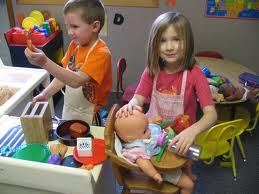It is very important to support creativity in your children and give them an outlet to express themselves. Set up a table with paper and various writing utensils and let your children draw.
If you are wondering how your child’s drawing will progress, the outline below will be helpful.
Starting about fifteen months, children begin to draw zig-zag lines. This is a motor activity. The child is not trying to represent anything on paper.

At about three years or older, children begin to represent their thoughts on paper. The image could still appear to be scribbles but children assign meaning to their drawing. You can tell this because if they are drawing with someone else, they will talk about their drawing. The meanings of the drawings can change as well. Though, if you ask them what their painting mean and they haven’t thought of anything, they might just make something up to please you.

Also, at about three, many children make circular motions on paper. Eventually, these turn into discrete circles. Once they start making circles, the round shapes start becoming suns and people’s faces.

The next phase will be arms and legs coming straight out of the head. Later, they add bodies often with belly buttons. 🙂

Children don’t put the details of their drawings in perspective. Objects are often floating in space. Also, whatever is most important in a child’s mind will loom largest.

Children draw what they are thinking about not what is in front of them. A study was done of children drawing their mother’s faces. First, they drew the faces without their mother being present. Then they were asked to draw again with their mother facing them. The drawings were the same. Also, children will draw “x-ray” pictures where things normally blocked from view are still shown. A driver drawn inside a car will have both arms and legs shown.

To help your child progress through this sequence, be sure and offer lots of crayons, paper and general art materials.
Reference
Lasky, L., Mukerji-Bergeson,R. (1980). Art: Basics for young children . Washington, DC: National
Association for Educators of Young Children.



